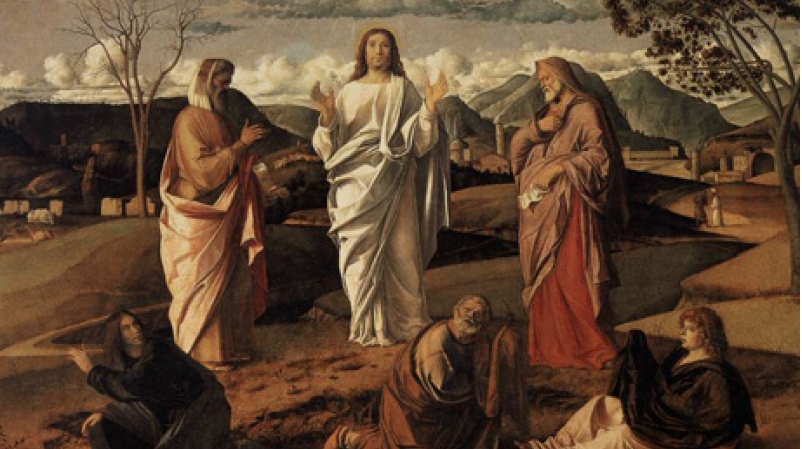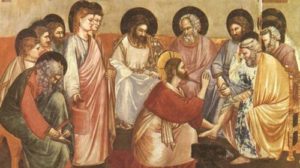
“And he was transfigured before them, and his face shone like the sun, and his garments became white as light.” (Mt. 17:2)
“and his face was like the sun shining in full strength.” (Rev. 1:16)
In this Easter season, the mystery of the Resurrection remains ever before us. Christ rose bodily from the dead. In other words, a human being overcame death! This is the Good News we should be shouting from the rooftops. This is why Christianity is unique. Of course, Christ was not just human. He was, and is, fully God. Christ was the forerunner in a bodily resurrection, the first fruit, so that we may one day, on the last day, also rise bodily for all eternity. St. Paul tells us, “And as in Adam all die, so also in Christ all shall be made alive.” (1 Cor. 15:22) As all humanity inherited sin and death from Adam, now all humanity can rise to eternal life – either for good or for woe.
That moment of Christ’s Resurrection, perhaps, was caught like in a photographic snapshot in time. The Shroud of Turin may very well be that imprint of the Resurrection, although the Church has not ruled definitively on its authenticity. La Stampa, the Vatican Insider site, reported in 2011 on an ENEA (the National Agency for New Technologies, Energy and Sustainable Economic Development) report that researched the Shroud to try to understand the processes of its creation. It has already been scientifically established that the Shroud was not created with paint, as some medieval forgery. Rather, scientific studies have shown the image of the Shroud was imprinted with a light source of intense radiation. In fact, the ENEA report states that “34 thousand billion watts” of VUV (Vacuum Ultraviolet light) was needed to make the image on the Shroud. That’s 34,000,000,000,000 watts of ultraviolet light energy! Since “the most powerful available [laser excimers] on the market come to several billion watts,” this is something not doable even by modern science, much less a Michelangelo of the Middle Ages.
The 21st century world of physics blushes. Our technological era is a time when we hardly believe the supernatural could intrude upon the empirical data-driven world of modern science. Yet, here we are. Occasionally, we do witness the miraculous – where the ethereal divine mysteries poke a hole through the veil of materialism, and its scrupulous pieties.
In 2006, in Assiut, Egypt, a backwater of the Nile, divine mysteries again burst into the seemingly natural and the mundane. It was during this time frame that a number of miraculous occurrences happened throughout Egypt. The Blessed Virgin Mary appeared throughout Egypt in Zeitoun (as I wrote about here), in Watan, in Assiut, perhaps retracing, in the twenty-first century, the steps of the Holy Family’s first century sojourn into Egypt. Assiut is traditionally the southern most point that the Holy Family reached in their flight from Herod’s onslaught against the innocence.
On Wednesday March 29, 2006, there was a purported miraculous event that we can consider for our discernment. An Orthodox Christian congregation was praying at St. Michael’s Coptic Church in Assiut. During the liturgy, a miraculous light came upon the tray of the Eucharist so that “all they could see was light.” The worshipers inside the Church receiving the Eucharist saw and felt the light as well. One of the worshipers present at receiving Communion said, “all she could see is light in the tray and light in the hands of Abouna [i.e., the priest] whilst he gave her the body of Christ to partake of. As she partook of this light, she event felt as if she was chewing light!” The Eucharist had turned to a bright unfathomable light, and while partaking of the Eucharist the communicants felt as if they were eating light! These miraculous occurrences were supported by other miraculous events of onlookers seeing the Blessed Virgin Mary, flashes of white light, and appearances of divine doves.
The focus on light hearkens back to Scripture. The Gospel speaks of Jesus revealing his divinity repeatedly in a state of intense light. We see that at the Transfiguration, in the Resurrection, on the Road to Damascus, and in Revelation. Christ appears in an overwhelming burst of light of his glorified state. It is the glorified Christ, in perhaps that 34 trillion watts of radiation, that resurrects from the dead and imprints the Shroud. And, it is in that same light, that we receive in the Holy Eucharist. We, too, are eating the resurrected Body, Blood, Soul, and Divinity of Christ in the Eucharist. As Jesus explained the real presence to the dumbfounded Apostles, the Eucharistic manna is not the dead flesh of a corpse, but his very “spirit and life.” (Jn. 6:63) We receive the grace and power of the light of the resurrected God-man. It is for this reason that Christ tells us, “Truly, truly, I say to you, unless you eat the flesh of the Son of man and drink his blood, you have no life in you.” (Jn. 6:53) The flesh and the blood of the resurrected Son of God raises us to eternal life.
This necessitates that we approach each Eucharist in willful contrition and reverence. Faith and the Sacraments are our hope of eternal life. As I detailed in my book Burning Bush, Burning Hearts: Exodus as Paradigm of the Gospel, Christ is the fulfillment of the whole Old Testament and all of the Feasts of Exodus. The last and great Feast of the Jews is the Festival of Tabernacles. This is the great celebration of the Pouring of the Water and the Festival of Light. Jesus proclaims that he is the fulfillment of the living-water that is poured out for the forgiveness of sins through the water of Baptism and the pouring forth of the Holy Spirit. Jesus also proclaims himself the Light of the World, in fulfillment of the Ceremony of Light. Jesus is the Light of the World, and upon occasion, we are given a direct glimpse of his divine Light.
We still find these truths, even some 2,000 years later, as “the Light that shines in the darkness, and the darkness has not overcome it.” (Jn. 1:5) The Shroud and the Light of the Eucharist in Assiut confirm this. At each Mass, we are being transformed (2 Cor. 3:18) by Christ’s divine Light into his likeness, one Eucharist at a time.

